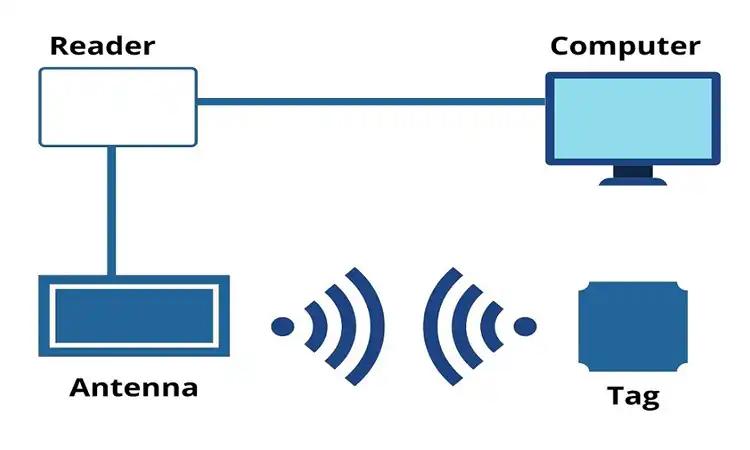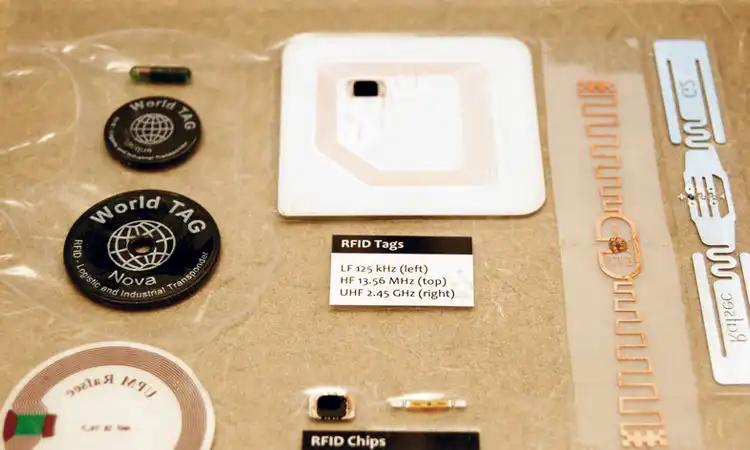RFID tags are small devices which use radio frequencies to transmit data. They are embedded in objects like clothing or other products and are used to identify and track them throughout a supply chain. Unlike barcodes, RFID tags don’t require physical contact with a scanner in order to be read – they can be read from several feet away using a RFID reader.
RFID Tags Definition
RFID, short for radio frequency identification, is a tracking system that uses intelligent barcodes to identify items. They transmit data from the tag to a reader, which sends the information to an RFID computer program, which can then track any object through radio waves. Not only can RFID tags be used for merchandise, but you can use them to track vehicles and pets.

How RFID Tags Work?
RFID technology uses radio waves from a reader (like an RFID scanner) that are broadcast through the air and into an object or person carrying an RFID tag attached somewhere to their body or clothing. The reader then captures information about what type of object takes the RFID tag – its size, shape, weight, color, and other attributes. And sends that information back to the computer program via radio waves for interpretation by human staff.
An RFID tag can hold up to 64 bytes of data and can be read by any kind of reader—as long as it has a compatible protocol. The most common protocols used by modern readers include ISO/IEC 14443 Type A (MIFARE) and ISO/IEC 14443 Type B (NFC). However, other types of readers are also available, including contactless cards or smartphones equipped with NFC chips that allow users to scan passes or tickets directly from their phones.
The information stored on an RFID tag can include a name, ID number, or other personal data about the person or object for whom it’s intended. It can also store information about the person or object’s location or movement patterns.

RFID Tags Types
RFID tags are tiny electrical devices that transmit and receive information via an antenna and a microchip. The microchip is what holds the information you want to transfer. There are two main types of RFID tags: battery-operated, which requires an onboard battery for power, and passive, which does not require external power sources but instead uses electromagnetic energy transmitted from an RFID reader.
Passive RFID tags use three main frequencies to transmit information:
● 125-134 KHz (also known as LF)
● 13.56 MHz (also known as HF)
● 865-960 MHz (also known as UHF)
The frequency of the signal used affects the range of the wireless device. When a reader scans a passive RFID tag, an electromagnetic wave is sent through it, powering it enough for its chip and antenna to relay information back to the reader. After receiving this information, an RFID computer interprets this data to identify items.
Active RFID tags are used when you must track an item remotely. The main difference between passive and active RFID tags is that active tags use a higher frequency, such as 433 MHz or 915 MHz, to transmit information. An RFID tag contains three main parts: an antenna and an interrogator. The batteries should supply enough power to last three to five years when the unit functions correctly. If it dies, the team will need replacing; currently, this can only be done by a technician who can access the inside of the device after removing it from its packaging. RFID tags come in two main varieties: beacons and transponders. Beacons send a data signal every few seconds, but they do it so frequently that their battery life is short. Transponders are more efficient than beacons; they send out the signal only when near a reader, so their battery lasts longer.
RFID VS NFC VS Barcode
Here is a table comparing RFID, barcode, and NFC technology:
| Feature | RFID | Barcode | NFC |
| Definition | Radio Frequency Identification is a technology that uses radio waves to communicate between a reader and a tag. | Barcodes are a method of representing data in a visual, machine-readable form. | Near Field Communication is a technology that uses magnetic fields to communicate between two devices. |
| Use case | Asset tracking, Inventory management, Supply chain management, and Access control. | Product identification and tracking, Inventory management and data collection. | Mobile payments, Data transfer, and Contactless Identification |
| Range | RFID tags can have a range of up to 100 meters or more. | Barcodes need to be scanned within close proximity (a few centimeters to a meter) to the barcode reader. | NFC communication range is limited to a few centimeters. |
| Speed | RFID tags can be read very quickly, in a fraction of a second. | Barcodes can be read quickly, in a few seconds. | NFC communication is fast, taking only a fraction of a second. |
| Cost | RFID tags and readers can be more expensive compared to barcode technology. | Barcode technology is relatively low cost. | NFC technology is relatively low cost. |
| Data storage | RFID tags can store large amounts of data, several kilobytes. | Barcodes can only store limited data, a few characters to a few hundred characters. | NFC tags can store limited data, a few kilobytes. |
| Security | RFID technology is more secure compared to barcodes, as the data is encrypted. | Barcodes can be easily duplicated or forged. | NFC technology is secure and the data is encrypted. |
Note: This table compares RFID, barcode, and NFC technology and may not apply to all specific cases.
Examples of RFID Tags
Active RFID tags constantly send out signals and are an excellent choice for those looking for up-to-the-minute live tracking. They are expensive, but they have longer read ranges than passive IC tags and can be helpful in tolling and real-time vehicle tracking applications.
Active RFID tags, which are smaller and more rugged than passive RFID tags, are often used in applications where durability is essential. They are frequently found as toll payment transponders and in cargo tracking systems. They also can be used to track people in certain situations.
Passive RFID tags are a much more economical choice than active RFID tags. They cost around 20 cents each, making them popular in supply chain management, race tracking, file management, and access control applications. They are small in size and lightweight, making them ideal for use in mobile applications.
Passive tags are also more secure than active ones because they don’t require batteries or power cords to operate. Because they do not have an internal battery or power source, they are less likely to fail over time or be tampered with by thieves who would like to steal your information from these devices.
RFID tags are used for a variety of purposes, including:
– Tracking goods in transit
– Inventory control
– Secure access control
– Access control in retail environments
RFID Standards
RFID technology has been around since 1973 when IBM first used it for inventory tracking. Since then, many companies have invested heavily in RFID solutions because of their convenience and efficiency advantages over manual systems such as barcodes or human supervisors.
There are several guidelines and specifications for RFID technology:
● International Organization for Standardization (ISO) is an international organization based in Geneva that develops technical standards related to all industries across the globe. It includes manufacturing processes (e.g., production lines), transport systems (e.g., railways), communication technologies (e.g., satellite communications), etc.).
● The Electronics Product Code Global Incorporated (EPCglobal) is responsible for all the standards and protocols used to manage, track, and authenticate RFID tags globally. They have created a set of criteria covering a tag’s life cycle and its various operating modes.
● The International Electrotechnical Commission (IEC) is another organization that has developed standards for radio frequency identification technology. They have defined two classes of RFID tags: Class 1 and Class 2, which are used in different situations.
Each radio frequency has associated standards:
– ISO/IEC 14443: specifies how an RFID tag should respond to commands given by a reader
– ISO 15693: details how an RFID tag should store data when it’s in proximity to another tagged object
– ISO 18000-6C: defines how a UHF RFID tag communicates with nearby devices
Frequency of Use in Different Countries
RFID tags are a necessary tool for the modern world. They can help track inventory, reduce theft, and increase employee productivity by reducing errors. However, some countries have a different frequency of RFID tag use than others.
-Low Frequency (LF) tags: These are used in the United States and Europe. They use radio frequencies between 13 kHz and 1 MHz
-High Frequency (HF) tags: These are used in Japan and Korea. They use radio frequencies between 135 kHz and 860 kHz
-Ultra High Frequency (UHF) tags: These are used in China, India, Brazil, Mexico, Australia, New Zealand, South Africa, and other countries worldwide. They use radio frequencies between 315 kHz and 902 MHz
Disadvantages of RFID Tags
RFID technology is not always the best solution for businesses looking to track their inventory. In fact, it has several disadvantages and drawbacks that can be hard to overcome:
1. RFID tags cannot distinguish between readers, so they can be read by almost anyone once they’ve left the original supply chain. This means that anyone with access to an RFID reader can access any information collected by fraudsters, even if some data is encrypted or otherwise protected.
2. RFID readers are so portable that they can be carried around by individuals who don’t know what they’re doing or how to keep private data safe from prying eyes and ears. This means that people can gather sensitive information without knowing they’re doing it, making it easier for them to commit fraud or theft.
3. RFID tags can make saving and retrieving items at a store more efficient, but in some instances, they may be linked to individual credit cards. This can lead to financial theft and fraud if not appropriately handled.
4. There are no real global or industry standards on how these tags should function, so there is no guarantee that they will work as they should. They can become jammed or disrupted, resulting in longer wait times and decreased productivity in retail and warehouse settings.
5. One drawback of RFID inventory systems is that they require a significant amount of time and labor to set up. This can increase the cost of the system itself, as well as any additional fees for data collection.
6. Companies are also limited by the types of devices that can be used for each kind of reader, making it difficult to use different types of scanners with different tags.
But even with these inevitable challenges, it is still a welcome presence.You can’t escape the fact that RFID tags are everywhere. In fact, a study done by the United States Department of Commerce estimates that there are approximately 8 billion RFID tags in use today, with the number expected to grow to 15 billion by 2025. That’s why businesses must understand how these tags work and how to use them effectively in their business.
